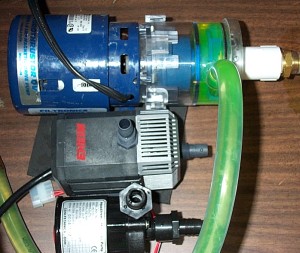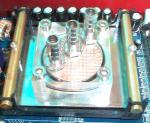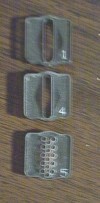|
|
|
|
 DangerDen TDX Nozzle tests DangerDen TDX Nozzle tests
|
|
Date Posted: May 20 2004
|
|
Author: pHaestus
|
|
|
|
|
Posting Type: Review
|
|
Category: H2O and High End Cooling Reviews
|
|
Page: 1 of 1
|
|
Article Rank:No Rank Yet
Must Log In to Rank This Article
|
|
|
|
|
Note: This is a legacy article, imported from old code. Due to this some items on the page may not function as expected. Links, Colors, and some images may not be set correctly.
|
|
|
DangerDen TDX Nozzle tests By: pHaestus
|
|
|
Danger Den TDX Nozzle Testing
By: pHaestus 5/20/04
|
|
|
Let's cut to the chase here. As soon as the Danger Den TDX waterblock review was posted, two questions started popping up on the web:
"Is the TDX better than the Danger Den RBX?"
"How does TDX performance change with different nozzles?"
Although quality reviews of the TDX were posted on Friday at Overclockers and Procooling, no one has fully answered the above questions. Joe used different nozzles for his tests and reported performance only for one flow rate, while I posted
results as a function of flow with no measure of waterblock resistance. Today I will try to address these questions by testing the TDX with nozzle inserts #1 (stock), #4, and #5. The #4 is 20% narrower
than the stock nozzle, and #5 has multiple holes that match up with small divots in the TDX baseplate. Both nozzles are considered "performance boosters" around the web, but whether the flow rate reduction
that comes with adding these nozzles negates the performance gain in a typical cooling system is unknown.
|
|
|
|
Test Results and Observations
|
|
|
|
|
|
|
|
|
|
 Testing methods are the same as used in earlier waterblock reviews. One new development is the estimation that my TBredB 1700+ at
13x175fsb and 1.85V (BIOS) generates approximately 73W under load. I am hesitant to convert the graphs from deltaT to C/W as of yet (still playing with this sort of W estimation), but that should give
you a ballpark number for CPU power. Rather than use the included springs from Danger Den, I used the same mounting hardware used in RBX, Whitewater, Cascade, Maze4, and #rotor block testing.
This ensures that all blocks are on a level playing field. Testing methods are the same as used in earlier waterblock reviews. One new development is the estimation that my TBredB 1700+ at
13x175fsb and 1.85V (BIOS) generates approximately 73W under load. I am hesitant to convert the graphs from deltaT to C/W as of yet (still playing with this sort of W estimation), but that should give
you a ballpark number for CPU power. Rather than use the included springs from Danger Den, I used the same mounting hardware used in RBX, Whitewater, Cascade, Maze4, and #rotor block testing.
This ensures that all blocks are on a level playing field.
A word of explanation about the following graphs may be helpful. I measure CPU diode temperature, the temperature of the water at the
waterblock's inlet, and the water flow rate. By plotting the difference between CPU temperature and water temperature, we can normalize all testing. This is required because water temperatures may vary
from day to day in my testing room. The closer that this delta T (engineering-speak for temperature differential) is to 0, the better the waterblock is performing.
Results for the TDX with nozzle 1, 4, and 5 are graphed below. The Little River Cascade and Danger Den
RBX are shown for comparative purposes.
|
|
 |
|
|
There is a lot of information to digest, but a few items should be clear. First of all, with the #4 or #5 nozzles installed, I find the TDX
outperforms the RBX (with #1 nozzle) at any flow rate. This is in contrast to Joe's
testing at Overclockers.com. He found the TDX with #4 to perform worse than the RBX with #1 by 0.01C/W (in fact only 0.004 C/W
unrounded). I believe that the different outcome in our testing is due to difficulty in reproducibly mounting the RBX in my system. Joe has gone to great lengths to assure flat mounting with equal pressure every
time. Performance of the RBX may be a bit better under those ideal conditions. Also note that performance of the #4 nozzle tracks VERY closely to that of the RBX with nozzle #1. It's also noteworthy that the
TDX with #5 nozzle can match the performance of the Little River Cascade at 2.0 GPM. At lower flow rates, though, the Cascade remains far ahead regardless of nozzle choice.
|
|
 Although the above graph and discussion is interesting and useful for waterblock designers, I am not certain it is all that beneficial to consumers
. Flow rate only tells half of the story, after all. One might conclude from the above graph that the TDX plus #5 nozzle is the "best", but when plumbed into a restrictive loop with a low pressure pump, this
may not be true. To make some more concrete recommendations for you guys, I next conducted some flow rate testing with two typical water cooling pumps: an Eheim 1048, and an
AquaXtreme 50Z-DC12. The Eheim represents a low pressure, low flow pump (but very quiet), while the RZ50 is a higher pressure pump. I fitted together a test loop consisting of: Black Ice
Extreme, 3 feet of 1/2" ID Clearflex tubing, a reservoir with 5/8" barbs, a Swissflow flowmeter, and a TDX waterblock with different nozzles. Here are the results (they are plus or minus ~ 3%): Although the above graph and discussion is interesting and useful for waterblock designers, I am not certain it is all that beneficial to consumers
. Flow rate only tells half of the story, after all. One might conclude from the above graph that the TDX plus #5 nozzle is the "best", but when plumbed into a restrictive loop with a low pressure pump, this
may not be true. To make some more concrete recommendations for you guys, I next conducted some flow rate testing with two typical water cooling pumps: an Eheim 1048, and an
AquaXtreme 50Z-DC12. The Eheim represents a low pressure, low flow pump (but very quiet), while the RZ50 is a higher pressure pump. I fitted together a test loop consisting of: Black Ice
Extreme, 3 feet of 1/2" ID Clearflex tubing, a reservoir with 5/8" barbs, a Swissflow flowmeter, and a TDX waterblock with different nozzles. Here are the results (they are plus or minus ~ 3%): |
|
 |
|
|
We can now use the delta T vs. flow rate graph and the flow test results together to predict which nozzle would provide best performance in each case. I
did this by simply eyeballing the graph and tabulating the temperature rise that corresponded to measured flow rate. These estimates are plus or minus ~0.25 C.
|
|
 |
|
|
Ahhh finally something the average reader can USE! It is clear that for all the pumps tested that using the #4 or #5 nozzle results in improved
temperatures. It also becomes apparent that, for nozzles #4 and #5, the gain from changing to the more restrictive #5 nozzle is offset by the accompanying decrease in flow rate. Since nozzle #4 and 5 perform so
closely together, I would recommend the #4 for TDX users. My rationale for this is that the little holes in the #5 nozzle will clog very easily and I think the #4 will be less intensive to maintain. In fact, I would
recommend the #4 even for those with low pressure pumps as it outperforms the #1 even with weaker pumps. Finally, you can also see that both flow rates AND cooling are very similar between the TDX using nozzles #4 and #5
and that of the RBX.
Thanks again to Danger Den for providing the Dangerden TDX for testing. Also thanks goes to Bruce at Cooltechnica for providing both the 50Z-DC12 pump and the Danger Den RBX waterblock.
|
|
|
|
| Random Forum Pic |
 |
| From Thread: Post pictures of your homebuilt blocks here! |
|
| | ProCooling Poll: |
| So why the hell not? |
|
I agree!
|
 67% 67%
|
|
What?
|
 17% 17%
|
|
Hell NO!
|
 0% 0%
|
|
Worst Poll Ever.
|
 17% 17%
|
Total Votes:18Please Login to Vote!
|
|






 DangerDen TDX Nozzle tests
DangerDen TDX Nozzle tests

 Testing methods are the same as used in
Testing methods are the same as used in 
 Although the above graph and discussion is interesting and useful for waterblock designers, I am not certain it is all that beneficial to consumers
. Flow rate only tells half of the story, after all. One might conclude from the above graph that the TDX plus #5 nozzle is the "best", but when plumbed into a restrictive loop with a low pressure pump, this
may not be true. To make some more concrete recommendations for you guys, I next conducted some flow rate testing with two typical water cooling pumps: an Eheim 1048, and an
AquaXtreme 50Z-DC12. The Eheim represents a low pressure, low flow pump (but very quiet), while the RZ50 is a higher pressure pump. I fitted together a test loop consisting of: Black Ice
Extreme, 3 feet of 1/2" ID Clearflex tubing, a reservoir with 5/8" barbs, a Swissflow flowmeter, and a TDX waterblock with different nozzles. Here are the results (they are plus or minus ~ 3%):
Although the above graph and discussion is interesting and useful for waterblock designers, I am not certain it is all that beneficial to consumers
. Flow rate only tells half of the story, after all. One might conclude from the above graph that the TDX plus #5 nozzle is the "best", but when plumbed into a restrictive loop with a low pressure pump, this
may not be true. To make some more concrete recommendations for you guys, I next conducted some flow rate testing with two typical water cooling pumps: an Eheim 1048, and an
AquaXtreme 50Z-DC12. The Eheim represents a low pressure, low flow pump (but very quiet), while the RZ50 is a higher pressure pump. I fitted together a test loop consisting of: Black Ice
Extreme, 3 feet of 1/2" ID Clearflex tubing, a reservoir with 5/8" barbs, a Swissflow flowmeter, and a TDX waterblock with different nozzles. Here are the results (they are plus or minus ~ 3%): 
